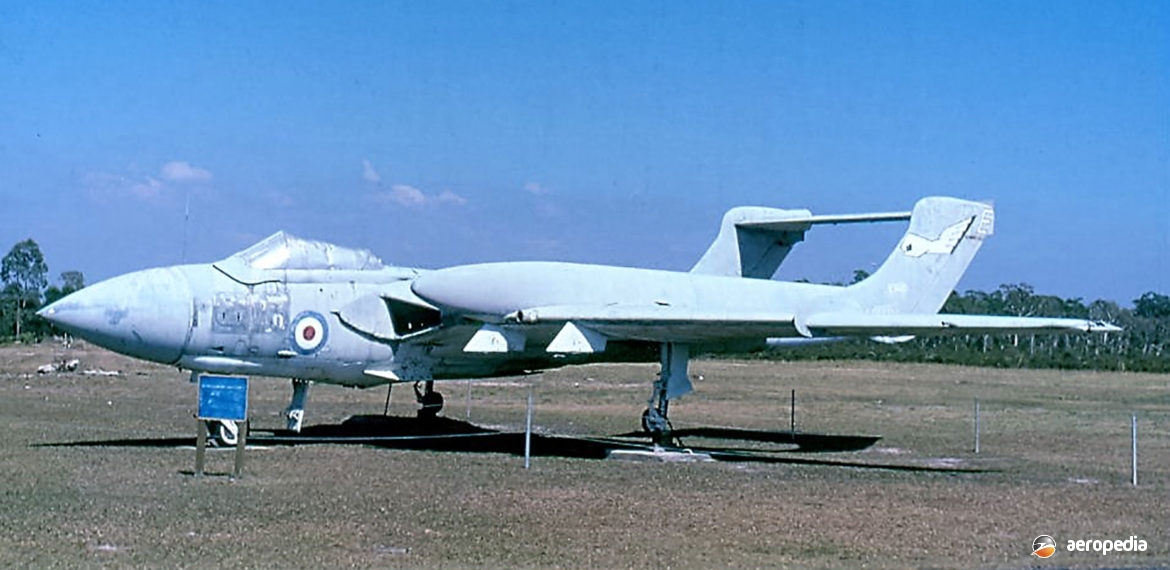Photograph:
de Havilland DH.110 Sea Vixen FAW Mk 2 XJ490 at the Queensland Air Museum at Caloundra, QLD (David C Eyre)
Country of origin:
United Kingdom
Description:
Two-seat naval all-weather fighter
Power Plant:
(FAW Mk 1)
Two 11,230 lbst Rolls Royce Avon Mk 208 turbojets
Specifications:
- Wingspan: 15.24 m (50 ft)
- Length: 16.94 m (55 ft 7 in)
- Height: 3.27 m (10 ft 9 in)
- Wing area: 60.2 m² (648 sq ft)
- Max speed at sea level: 1,110 km/h (690 mph)
- Max speed at 3,048 m (10,000 ft): 1,038 km/h (645 mph)
- Cruising speed at 3,050 m (10,000 ft): 563 km/h (350 mph)
- Climb to 3,050 m (10,000 ft): 1 min 30 seconds
- Climb to 12,192 m (40,000 ft): 6.5 mins
- Service ceiling: 14,630 m (48,000 ft)
- Loaded weight: 15,876 kg (35,000 lb)
Armament:
Four de Havilland Firestreak passive infra-red air-to-air missiles; two retractable nose pods each containing twenty-four 51 mm (2 in) rockets; up to four 227 kg (500 lb) bombs on underwing racks
History:
Originally designed as a land-based all-weather fighter for the Royal Air Force (RAF) in competition with the Gloster Javelin, the de Havilland Sea Vixen, or DH.110, was flown in prototype form (WG236) on 26 September 1951, a second aircraft (WG240) joining the test program on 25 July 1952, both aircraft being built in the Experimental Department at Hatfield in Hertfordshire. During the development program the prototype exceeded the speed of sound in a shallow dive on 9 April 1952. However, on 6 September, whilst being demonstrated at the SBAC show at Farnborough in Hampshire the DH.110 broke up in the air. The second aircraft was grounded and modifications were made to the wing structure.
After losing out to the Gloster Javelin, the second Sea Vixen was put forward as a high-performance all-weather fighter and strike aircraft to replace the de Havilland Sea Venom. It underwent trial landings on board ‘HMS Albion’ in 1954, and in 1956 a navalised variant was tested on board ‘HMS Ark Royal’, leading to an initial order for 45 aircraft for the Royal Navy.
On 5 March 1957 the type was named Sea Vixen FAW Mk 20, later becoming the Sea Vixen FAW Mk 1. The naval aircraft had a hinged radome, power folding wings, and a hydraulically steerable nosewheel, primary armament being the de Havilland Firestreak infra-red homing missile. Further trials were undertaken on board ‘HMS Victorious’ and ‘HMS Centaur’ and the type became operational with No 892 Squadron on board ‘HMS Eagle’. A total of 148 Sea Vixens was built, of which 67 were later upgraded to Mk 2 standard.
First Royal Navy unit to receive the Mk 2 was No 899 Squadron at Yeovilton in Somerset, which in December 1964 embarked on the ‘HMS Eagle’ to participate in the Rhodesian blockade. This was also the last unit to operate the type, being disbanded in January 1972. Surviving aircraft were allocated to RAE Llanbedr in Wales and Farnborough for conversion to pilotless drones, becoming known as the Mk 3.
Two of the type saw service in Australia during missile testing at Woomera, SA. These were both Mk 1s, XJ476 being the third production aircraft, and XJ481. Both were shipped from the United Kingdom and arrived in April 1960, returning to the United Kingdom in 1962. XJ476 later was involved in Martel missile trials in 1970, these being trials of an Anglo-French anti-radiation missile. The aircraft crashed landing at Boscombe Down in Salisbury on 21 September 1973. It ended its days on the fire dump there.
XJ481 was first flown on 2 September 1958 and was allocated to the A&AEE at Boscombe Down for trials. It also was engaged in the Martel missile trials in 1970, later going to the Fleet Air Arm Museum at Yeovilton. It was later loaned to other museums before going to the R J Mitchell Memorial Museum in Southampton.
Very little is known of their service in Australia but XJ476 was used initially for radar and sighting trials in the United Kingdom. Then it and XJ481 were painted white overall for the missile trials at the Woomera Rocket Range which involved testing of the de Havilland Firestreak air-to-air missile. It is known they were received at Edinburgh, SA on 14 April 1960 and served with No 1 ATU before being despatched to Adelaide on 18 December 1962 and being shipped to Belfast in Ireland on the ‘S S Dorset’.
In 1989 the Queensland Air Museum at Caloundra obtained Sea Vixen FAW Mk 2 XJ490 from Sentosa Island in Singapore, along with a Hawker Hunter and a Gloster Meteor F.8. The Sea Vixen has since been restored and placed on display. Converted to Mk 2 standard from Mk 1, this aircraft served with No 899 Squadron of the RN Fleet Air Arm on board ‘HMS Eagle’. In 1997 the Queensland Air Museum obtained from the United Kingdom the nose section of another Sea Vixen, this being XJ607, which has been placed on display, particularly during open cockpit days.

